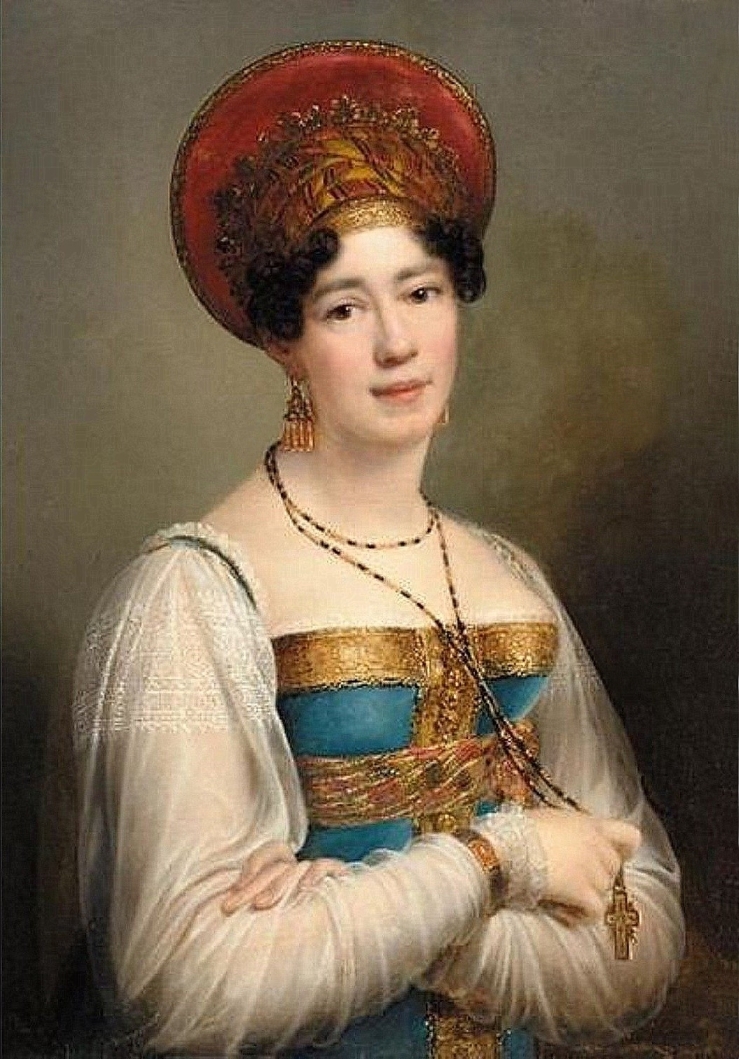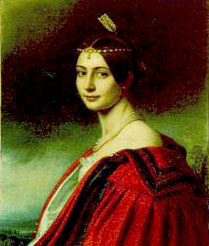|
Yekaterina Gagarina
Yekaterina Petrovna Gagarina (russian: Екатерина Петровна Гагарина; May 25, 1790—February 27, 1873), maiden name Soymonova (), was a wife of a Russian diplomat Grigory Gagarin, Prince Grigory Gagarin and the daughter of the Secretary of State Pyotr Soymonov. Biography Ancestors of Yekaterina Gagarina played a significant role in Russian history. Her father, Pyotr Soymonov (1737-1800), was a senator and a full Privy Councillor, and her mother Yekaterina (1756-1790) was a daughter of Gen. Ivan Boltin, a famous historian, a member of the Russian Academy. Yekaterina's childhood passed among the strife between father and grandmother from her mother side, who wanted to take her granddaughter to his upbringing. The matter went to Catherine the Great, but the Empress did not wish to interfere in the domestic affairs of Pyotr Soymonov. Duties of the court did not hinder Soymonov to devote enough time to his daughter. Yekaterina was brought up in the ... [...More Info...] [...Related Items...] OR: [Wikipedia] [Google] [Baidu] |
Grigory Gagarin
Prince Grigory Grigorievich Gagarin (russian: link=no, Григорий Григорьевич Гагарин, - ) was a Russian painter, Major General and administrator. His paternal grandparents were Prince Ivan Sergeievich Gagarin and wife. His father married in Saint Petersburg in 1809 his mother Yekaterina Petrovna Sojmonova (Saint Petersburg, 23 May 1790 - Moscow, ), daughter of Pyotr Alexandrovich Soimonov and wife Yekaterina Ivanovna Boltina. Thus until the age 13 the boy was with his family in Paris and Rome and then studied in the collegium Tolomei in Siena. Grigory did not receive a formal artistic education, but took private lessons from the famous Russian painter Karl Briullov who at that time lived in Italy.Grigory Gagarin in Staratel art library In 1832 he returned to Saint Petersburg, bec ... [...More Info...] [...Related Items...] OR: [Wikipedia] [Google] [Baidu] |
Catherine The Great
, en, Catherine Alexeievna Romanova, link=yes , house = , father = Christian August, Prince of Anhalt-Zerbst , mother = Joanna Elisabeth of Holstein-Gottorp , birth_date = , birth_name = Princess Sophie of Anhalt-Zerbst , birth_place = Stettin, Pomerania, Prussia, Holy Roman Empire(now Szczecin, Poland) , death_date = (aged 67) , death_place = Winter Palace, Saint Petersburg, Russian Empire , burial_date = , burial_place = Saints Peter and Paul Cathedral, Saint Petersburg , signature = Catherine The Great Signature.svg , religion = Catherine II (born Sophie of Anhalt-Zerbst; 2 May 172917 November 1796), most commonly known as Catherine the Great, was the reigning empress of Russia from 1762 to 1796. She came to power following the overthrow of her husband, Peter III. Under her long reign, inspired by the ideas of the Enlightenment, Russia experienced a renaissance of culture and sciences, which led to the founding of m ... [...More Info...] [...Related Items...] OR: [Wikipedia] [Google] [Baidu] |
Sophie Swetchine
Anne Sophie Swetchine (''née'' Sofia Petrovna Soymonova; 22 November 178210 September 1857), known as Madame Swetchine, was a Russian mystic, born in Moscow, and famous for her salon in Paris. Biography She was born Sofia Petrovna Soymonova (sometimes Soïmonov or Soymanof) on 22 November 1782 in Moscow, the daughter of Secretary of State Peter Alexandrovich Soimonov (1734–1801) and his wife, Catherine Boltin (1756–1790). She spent her early years at the court of Empress Catherine the Great, as her father was one of the empress's closest advisors. She was given a good education, learned to speak several European languages and was popular at court. In 1797, she was made lady-in-waiting to Empress Maria Fedorovna. In 1799, Sophie married General Nicholas Sergeyevich Swetchine. Even though he was his wife's senior by 25 years, their relationship was described by contemporaries as a good one, though the couple did not have children, which is said to have caused her sufferin ... [...More Info...] [...Related Items...] OR: [Wikipedia] [Google] [Baidu] |
Maria Naryshkina
Maria Antonovna Naryshkina (Russian language, Russian: Мария Антоновна Нарышкина, 1779–1854), born Princess Maria Czetwertyńska-Światopełk, was a Polish noblewoman who was the mistress (lover), mistress of Tsar Alexander I of Russia for 19 years. Early life Born into the Czetwertyński, House of Światopełk-Czetwertyński, she was the daughter of the Polish prince Antoni Stanisław Czetwertyński-Światopełk and his wife, Tekla von Campenhausen, Kampenhausen (1750-1791). Biography In 1795, she married Dmitry Lvovich Naryshkin family, Naryshkin (1758-1838), a hofmeister (office), hofmeister. In 1799, with her spouse's approval, she entered into a relationship with Alexander, who became tsar in 1801. She was well liked by Alexander's family, except by his consort, the empress Elizabeth Alexeievna (Louise of Baden), Elizabeth Alexeievna. She is described as fascinating and charming, with the ability to attract people, and called "The Aspasia of the N ... [...More Info...] [...Related Items...] OR: [Wikipedia] [Google] [Baidu] |
Orest Kiprensky
Orest Adamovich Kiprensky (russian: Орест Адамович Кипренский -) was a leading Russian portraitist in the Age of Romanticism. His most familiar work is probably his portrait of Alexander Pushkin (1827), which prompted the poet to remark that "the mirror flatters me". Biography Orest was born in the village of Nezhnovo in the Saint Petersburg Governorate on . He was an illegitimate son of a landowner Alexey Dyakonov, hence his name, derived from ''Kypris'', one of the Greek names for the goddess of love. He was raised in the family of Adam Shvalbe, a serf. Although Kiprensky was born a serf, he was released from the serfdom upon his birth and later his father helped him to enter a boarding school at the Imperial Academy of Arts in Saint Petersburg in 1788 (when Orest was only six years old). He studied at the boarding school and the academy itself until 1803. He lived at the academy for three more years as a pensioner to fulfill requirements necessary ... [...More Info...] [...Related Items...] OR: [Wikipedia] [Google] [Baidu] |
Karl Bryullov
Karl Pavlovich Bryullov (russian: Карл Па́влович Брюлло́в; 12 December 1799 – 11 June 1852), original name Charles Bruleau, also transliterated Briullov and Briuloff, and referred to by his friends as "Karl the Great", was a Russian painter. He is regarded as a key figure in transition from the Russian neoclassicism to romanticism. Biography Karl Bryullov was born on 12 (23) December 1799 in St. Petersburg, in the family of the academician, woodcarver, and engraver Pavel Ivanovich Briullo (Brulleau, 1760—1833) who was of Huguenot descent. He felt drawn to Italy from his early years. Despite his education at the Imperial Academy of Arts (1809–1821), Bryullov never fully embraced the classical style taught by his mentors and promoted by his brother, Alexander Bryullov. After distinguishing himself as a promising and imaginative student and finishing his education, he left Russia for Rome where he worked until 1835 as a portraitist and genre painter, tho ... [...More Info...] [...Related Items...] OR: [Wikipedia] [Google] [Baidu] |
Vasily Zhukovsky
Vasily Andreyevich Zhukovsky (russian: Василий Андреевич Жуковский, Vasiliy Andreyevich Zhukovskiy; – ) was the foremost Russian poet of the 1810s and a leading figure in Russian literature in the first half of the 19th century. He held a high position at the Romanov court as tutor to the Grand Duchess Alexandra Feodorovna and later to her son, the future Tsar-Liberator Alexander II. Zhukovsky is credited with introducing the Romantic Movement into Russia. The main body of his literary output consists of free translations covering an impressively wide range of poets, from ancients like Ferdowsi and Homer to his contemporaries Goethe, Schiller, Byron, and others. Many of his translations have become classics of Russian literature, regarded by some to be better written and more enduring in Russian than in their original languages. Life Zhukovsky was born in the village of Mishenskoe, in Tula Governorate, Russian Empire, the illegitimate son of a l ... [...More Info...] [...Related Items...] OR: [Wikipedia] [Google] [Baidu] |
Fyodor Tyutchev
Fyodor Ivanovich Tyutchev ( rus, Фёдор Ива́нович Тю́тчев, r=Fyódor Ivánovič Tyútčev, links=1, p=ˈfʲɵdər ɪˈvanəvʲɪt͡ɕ ˈtʲʉt͡ɕːɪf; Pre-Reform orthography: ; – ) was a Russian poet and diplomat. Life Tyutchev was born into a Russian noble family in the Ovstug family estate near Bryansk (modern-day Zhukovsky District, Bryansk Oblast of Russia). His father Ivan Nikolaevich Tyutchev (1768—1846) was a court councillor who served in the Kremlin Expedition that managed all building and restoration works of Moscow palaces. One of Ivan's sister (1774—1837), was a hegumenia famous for founding the Borisoglebsky Anosin Women's Monastery.'' Ivan Aksakov (1997)''. Fyodor Ivanovich Tyutchev's Biography. — Moscow: AO Book and Business, p. 172-173 ''Gennady Chagin (2004)''. Fyodor Ivanovich Tyutchev. — Moscow: Russkiy mir, p. 17 The Tyutchevs traced their roots to Zakhariy Tutchev mentioned in ''The Tale of the Rout of Mamai'', a 1 ... [...More Info...] [...Related Items...] OR: [Wikipedia] [Google] [Baidu] |
1790 Births
Year 179 ( CLXXIX) was a common year starting on Thursday (link will display the full calendar) of the Julian calendar. At the time, it was known as the Year of the Consulship of Aurelius and Veru (or, less frequently, year 932 '' Ab urbe condita''). The denomination 179 for this year has been used since the early medieval period, when the Anno Domini calendar era became the prevalent method in Europe for naming years. Events By place Roman empire * The Roman fort Castra Regina ("fortress by the Regen river") is built at Regensburg, on the right bank of the Danube in Germany. * Roman legionaries of Legio II ''Adiutrix'' engrave on the rock of the Trenčín Castle (Slovakia) the name of the town ''Laugaritio'', marking the northernmost point of Roman presence in that part of Europe. * Marcus Aurelius drives the Marcomanni over the Danube and reinforces the border. To repopulate and rebuild a devastated Pannonia, Rome allows the first German colonists to enter territory ... [...More Info...] [...Related Items...] OR: [Wikipedia] [Google] [Baidu] |
1873 Deaths
Events January–March * January 1 ** Japan adopts the Gregorian calendar. ** The California Penal Code goes into effect. * January 17 – American Indian Wars: Modoc War: First Battle of the Stronghold – Modoc Indians defeat the United States Army. * February 11 – The Spanish Cortes deposes King Amadeus I, and proclaims the First Spanish Republic. * February 12 ** Emilio Castelar, the former foreign minister, becomes prime minister of the new Spanish Republic. ** The Coinage Act of 1873 in the United States is signed into law by President Ulysses S. Grant; coming into effect on April 1, it ends bimetallism in the U.S., and places the country on the gold standard. * February 20 ** The University of California opens its first medical school in San Francisco. ** British naval officer John Moresby discovers the site of Port Moresby, and claims the land for Britain. * March 3 – Censorship: The United States Congress enacts the Comstock Law, making it ... [...More Info...] [...Related Items...] OR: [Wikipedia] [Google] [Baidu] |
Gagarin Family
The House of Gagarin (russian: Гага́рин) is the name of a Russian princely family descending from sovereign rulers of Starodub-on-the-Klyazma. Origins The descendant of the Great Prince Vladimir Svyatoslavich, the Christianizer of Russia, Prince Ivan Vsevolodovich, received from his brother, the Great Prince Yaroslav Vsevolodovich, the appanage of Starodub, and this originated the Princes of Starodub. The great-great-grandson of this Prince Ivan, Prince Ivan Fedorovich, called Lapa-Golibesovskoy, had a son, Prince Mikhail, and he had three sons: Princes Vasilii, Yuri, and Ivan Gagara, whose descendants, the Princes Gagarin, served the Russian Throne as Boyars and in other distinguished positions. The history of the Russian Empire shows that many of the Princes Gagarin, both in ancient times as well as in more recent times, were granted fiefdoms for their service to the fatherland, and they were rewarded with several Orders and other tokens of the Monarch's favor. No ... [...More Info...] [...Related Items...] OR: [Wikipedia] [Google] [Baidu] |

.jpg)
.jpg)




